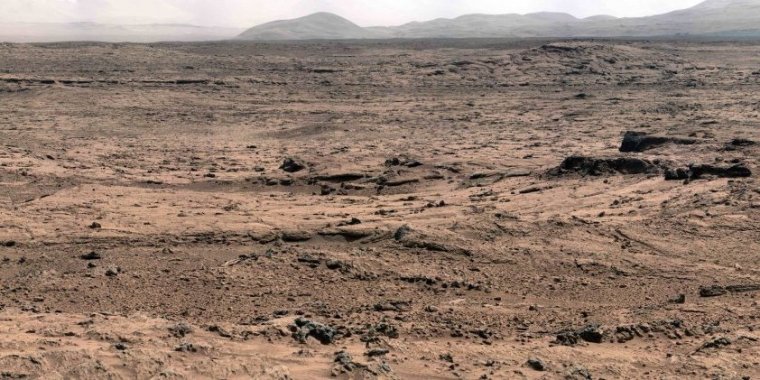| News / Space News |
Why is Methane Seeping on Mars?
The most surprising revelation from NASA’s Curiosity Mars Rover — that methane is seeping from the surface of Gale Crater — has scientists scratching their heads.

Curiosity's view of Gale's walls from Aeolis Palus at "Rocknest" looking eastward toward "Point Lake" (center) on the way to "Glenelg Intrigue" - Aeolis Mons is on the right. Photo: NASA/JPL-Caltech/Malin Space Science Systems
Living creatures produce most of the methane on Earth. But scientists haven’t found convincing signs of current or ancient life on Mars, and thus didn’t expect to find methane there.
Yet, the portable chemistry lab aboard Curiosity, known as SAM, or Sample Analysis at Mars, has continually sniffed out traces of the gas near the surface of Gale Crater, the only place on the surface of Mars where methane has been detected thus far. Its likely source, scientists assume, are geological mechanisms that involve water and rocks deep underground.
SAM has found that methane behaves in unexpected ways in Gale Crater. It appears at night and disappears during the day. It fluctuates seasonally, and sometimes spikes to levels 40 times higher than usual.
Surprisingly, the methane also isn’t accumulating in the atmosphere: ESA’s (the European Space Agency) ExoMars Trace Gas Orbiter, sent to Mars specifically to study the gas in the atmosphere, has detected no methane.
Methane keeps Mars scientists busy with lab work and computer modeling projects that aim to explain why the gas behaves strangely and is detected only in Gale Crater. A NASA research group recently shared an interesting proposal.
Reporting in a March paper in the Journal of Geophysical Research: Planets, the group suggested that methane — no matter how it’s produced — could be sealed under solidified salt that might form in Martian regolith, which is “soil” made of broken rock and dust. When temperature rises during warmer seasons or times of day, weakening the seal, the methane could seep out.
Led by Alexander Pavlov, a planetary scientist at NASA’s Goddard Space Flight Center in Greenbelt, Maryland, the researchers suggest the gas also can erupt in puffs when seals crack under the pressure of, say, a rover the size of a small SUV driving over it.
The team’s hypothesis may help explain why methane is detected only in Gale Crater, Pavlov said, given that’s it’s one of two places on Mars where a robot is roving and drilling the surface. (The other is Jezero Crater, where NASA’s Perseverance rover is working, though that rover doesn't have a methane-detecting instrument.)
Pavlov traces the origin of this hypothesis to an unrelated experiment he led in 2017, which involved growing microorganisms in a simulated Martian permafrost (frozen soil) infused with salt, as much of Martian permafrost is.
Pavlov and his colleagues tested whether bacteria known as halophiles, which live in saltwater lakes and other salt-rich environments on Earth, could thrive in similar conditions on Mars.
The microbe-growing results proved inconclusive, he said, but the researchers noticed something unexpected: The top layer of soil formed a salt crust as salty ice sublimated, turning from a solid to a gas and leaving the salt behind.
“We didn’t think much of it at the moment,” Pavlov said, but he remembered the soil crust in 2019, when SAM’s tunable laser spectrometer detected a methane burst no one could explain.
Pavlov’s team tested five samples of permafrost infused with varying concentrations of a salt called perchlorate that’s widespread on Mars. (There’s likely no permafrost in Gale Crater today, but the seals could have formed long ago when Gale was colder and icier.)
The scientists exposed each sample to different temperatures and air pressure inside a Mars simulation chamber at NASA Goddard.
Periodically, Pavlov’s team injected neon, a methane analog, underneath the soil sample and measured the gas pressure below and above it.
Higher pressure beneath the sample implied the gas was trapped. Ultimately, a seal formed under Mars-like conditions within three to 13 days only in samples with 5% to 10% perchlorate concentration.
That’s a much higher salt concentration than Curiosity has measured in Gale Crater. But regolith there is rich in a different type of salt minerals called sulfates, which Pavlov’s team wants to test next to see if they can also form seals.
YOU MAY ALSO LIKE





